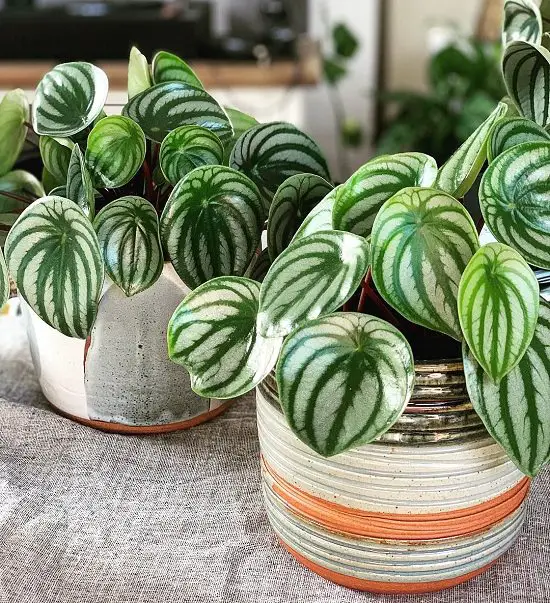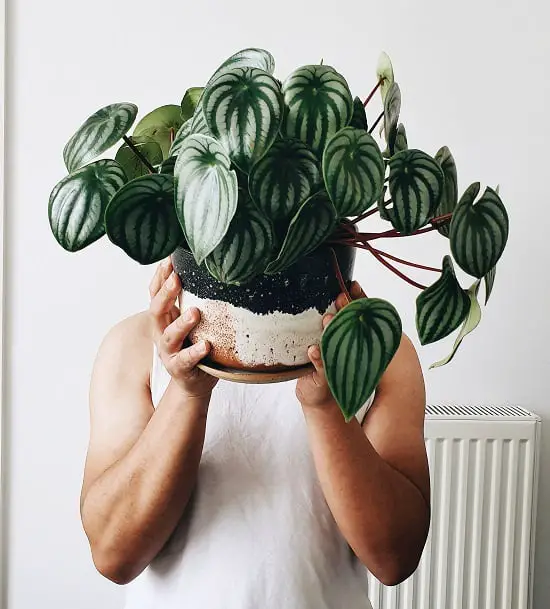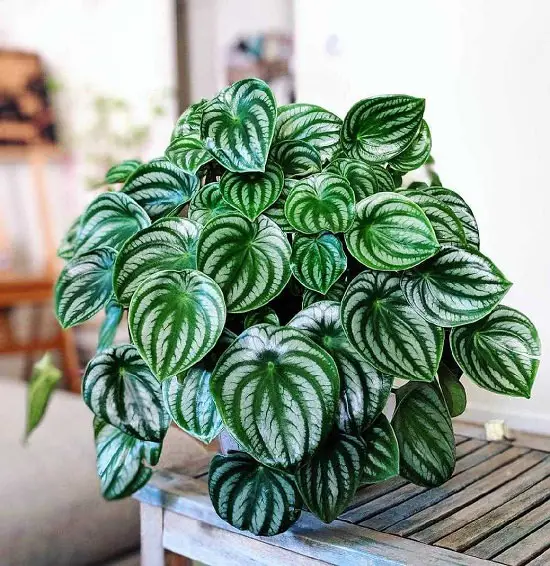Watermelon Peperomia Care is essential if you want to maintain its beautiful watermelon-like leaves marked with silver and dark green stripes!

Watermelon peperomia is one of the most popular species of the Peperomia genus. The reason behind this name is the silver-green stripes on the fleshy foliage, giving it a resemblance to the rind of a watermelon. It is commonly grown as a houseplant in containers. Continue reading to learn more about Watermelon Peperomia Care!
Other Names: Peperomia argyreia (Scientific Name), Watermelon Begonia
Height & Spread: 6-12 inches
Check out our article on how to take care of hibiscus indoors here!
How to Propagate Watermelon Peperomia
Watermelon peperomia can be planted from the leaf or stem cutting. Cut the leaves with stalks (petioles) 2-3 cm (1 inch) and dab them in the rooting hormone before planting. Keep the soil moist and warm!
If you are propagating the plant from stem cuttings, either grow it in soil, the way, you usually do, or place the stem in clean water. Change the water every 2-3 days. You will notice new roots emerging from the stem in 2-4 weeks.
Container Size
If you’re growing dwarf watermelon peperomia, one 4 inches pot should be fine. For a usual watermelon peperomia that is not too big, select a decorative 4-6 inches container, it can work for more than a year before the next pot upsize.
Tip: Select one or two sizes bigger pot than the size of the rootball of your peperomia plant. It grows best when it’s slightly rootbound!
Requirements for Growing Watermelon Peperomia
Location
The plant performs well in bright, indirect sunlight. Avoid exposing it to the direct, harsh sun to save the foliage from burning and heat stress, especially in a hot climate.
While planting indoors, place the plant on a north or east-facing window. You’ll need to reduce the intensity of light if you’re keeping it western or southern windowsill. Outdoors, grow the plant in the shade.
Soil
Use any regular houseplant potting mix. You can also prepare your own with the help of some suggested recipes here. Just remember, your substrate must be loamy and well-draining so that it doesn’t collect water.
Water
Water the plant when the top inch of soil looks dry and never allow the soil to be consistently moist. Keep an eye on the outdoor plant in warm weather as it may need more frequent irrigation. During fall and winter, reduce watering!
Temperature and Humidity
This plant cannot withstand freezing temperatures. Bring your outdoor plant indoors when the night-time temperature falls below 50 F (10 C). The ideal temperature is above 60 F (15 C). If you live in a hot climate, bring it indoors when the temperature starts to exceed above 100 F (37 C).
Watermelon peperomia is a warm climate plant, and it loves a humid surrounding. To maintain it, place the pot on a tray filled with water and pebbles. For tips on raising humidity, click here.
Watermelon Peperomia Care

Fertilizer
This beautiful specimen is a light feeder. An extra supply of nutrients may result in a weak, leggy, and excessive growth instead of a bushy, compact plant.
Fertilize the plant every 3-4 weeks during spring and summer and every 2 months in fall and winter (don’t fertilize in winter, if you live in a really cold climate) with a balanced, water-soluble fertilizer. Feed with half or one-quarter strength of the quantity suggested by the manufacturer. Avoid using granular fertilizer!
Repotting
The plant doesn’t require repotting, as it likes to live in a slightly pot-bound state. Repotting can be done after two or three years to 1 or 2 sizes bigger pots after the winter.
Here’s a list of fast-growing indoor plants that you can grow!
Pests and Diseases
Watermelon Peperomia doesn’t have any serious disease problems. However, you have to be careful about whitefly, spider mites, and mealybug infestation. They can be physically removed, or you can use a jet of water. Also, providing proper ventilation and cleaning of foliage helps in combating pest problems before the major onset.
Is Watermelon Peperomia Toxic to Cats & Dogs
Thankfully, these beautiful specimens are safe for both humans and pets and pose no risk to the children’s health.
Watermelon Peperomia Benefits
- An easy-to-grow plant, even for beginners.
- Small plant with showy, oval-shaped large leaves.
- Excellent for tabletops, shelves, and desks.
- Ability to reduce formaldehyde levels.
- It can be grown in water.



